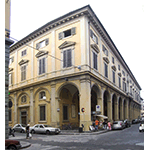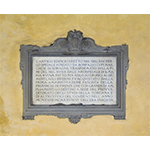Ex Ospedale di Bonifazio [Former Bonifazio Hospital]
Founded in 1380 by Bonifazio Lupi, the hospital was officially opened in 1388 to provide assistance to the poor and to invalids. Thanks to numerous donations and legacies, the institution grew over the years. In 1630 and 1633 it was used as a lazzaretto during an epidemic of plague that swept through the city. At the beginning of the 18th century it had a capacity of over 250 patients. From 1734 to 1736 it was the hospital of the Spanish troops.
Starting in 1780, in accordance with the project for reforming Florentine medical facilities promoted by Grand Duke Peter Leopold of Lorraine, all of the so-called "incurables" (those affected by illnesses considered chronic, that is, patients severely infected, mentally ill or invalids) were sent to the Bonifazio Hospital. The grand-ducal reform was implemented by Vincenzo Chiarugi, who in 1805 held the world’s first Chair of "Aphrodisiac Diseases and Mental Perturbation" at the University of Pisa, with the obligation to hold lessons at the Bonifazio as well, where he was Primus Infirmarius, that is, Chief Physician. He was thus the first professor of Dermatology and Mental Illness, since only later were these chairs to be instituted in other universities. With Chiarugi, who considered mental illness to be a pathological form that could be cured by treatment and not merely by isolating the patient, the Florentine School of Nervous, Mental and Derma-Syphilitic Diseases originated. Chiarugi not only introduced vitally important methods for curing mental diseases, but also adapted the internal structure of the building to the specific needs of the patients. These experiments culminated in 1840 with the institution of the first Chair of Mental Illnesses at the University of Florence, to which one of Chiarugi’s pupils, Vincenzo Capecchi, was appointed.
At the end of the 19th century, in coincidence with the construction of the San Salvi Psychiatric Hospital, the Bonifazio was transformed into a hospital for ophthalmic and tubercular patients and invalids, remaining such until 1924. Purchased by the Province, it served as site of the Provincial Education Office from 1927 to 1938, the year in which it was assigned to the Police Headquarters, which still occupies it today.
****************************
Texts by Antonella Gozzoli
English translation by Catherine Frost
Last update 18/feb/2008





